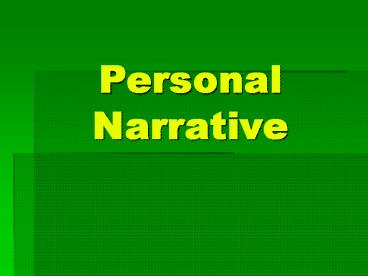Personal Narrative - PowerPoint PPT Presentation
1 / 13
Title: Personal Narrative
1
PersonalNarrative
2
Elements of a Personal Narrative
- Point of View
- Strong Lead
- Character and Setting
- Conflict
- Dialogue and Blocking
- Interior Monologue
- Show Dont Tell
- Strong Conclusion
3
Point of View
- Personal narratives are written in first person
point of view. - The narrator is a character in the story.
- First person pronouns are used to indicate the
writer is telling the story from his/her point of
view.
4
Strong Leads
- A strong lead immediately grabs the readers
attention by being out of the ordinary and
exceptionally interesting. - Strong lead ideas
- Short, arresting sentence
- Astonishing or shocking statement or scenario
- Exciting direct quotations
- Flashback
- ANY COMBINATION OF THE ABOVE
5
Character and SettingA good narrative develops
character and setting.
- Character Description
- Physical appearance
- Personality traits
- Directly stated
- Shown through actions and words
- Setting Description
- Elaborate description of place
- Sights, sounds, smells, tactile sensation, taste
- Time
6
Conflict
- The problem around which the narrative revolves
is called the conflict. - A good personal narrative cleverly introduces the
conflict, excitingly develops it, and
meaningfully resolves the conflict in the end.
7
Dialogue and Blocking
- Dialogue is when characters in the narrative
speak aloud to one another. - Dialogue should develop characters by giving
clues about their personalities and feelings. - There are specific rules for writing dialogue.
- Blocking is words that describe what the speaker
is doing as he/she speaks. - Stop! he shouted while angrily pounding his
fists on the table.
8
Interior Monologue
- Interior monologue tells what the character is
thinking and feeling inside his/her head. - It helps the reader discover more information
about the character. - It is often written in italics.
9
Show Dont Tell
- A good narrative develops the conflict and story
through the use of vivid, descriptive language. - He was tall. (telling - how boring!)
- His shadow loomed over my head, covering me in
darkness. (showing - yeah!) - Figures of speech such as simile and metaphor are
great ways to show not tell.
10
Strong Conclusion
- A personal narrative ends with a personal
revelation. - A revelation is a big ideaan important or
life-changing realization based on the narrative
experience. - This revelation is often stated directly, but can
be cleverly alluded to.
11
Analyzing Personal Narratives
- In the model narratives, find and analysis
examples of - Strong Leads
- Character and Setting Development
- Conflict
- Dialogue and Blocking
- Interior Monologue
- Showing Not Telling
- Strong Conclusions
- BE READY TO SHOW AND DISCUSS!
12
PROMPT
- Write about a time of self-realization, a moment
when you realized you were blind to a
situation, realized how it really was, and
learned something about the world and yourself.
13
Prewriting Lets begin!
- Brainstorm a list of moments of
blindness/realization that you might use (at
least 5 possibilities). - Choose one as your topic.
- Develop a list details about that event (at least
25 details).































